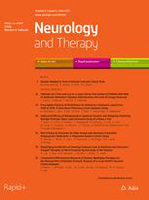
NEUROMUSCULAR DISORDERS
Scope & Guideline
Leading the way in pediatric neuromuscular research.
Introduction
Aims and Scopes
- Genetic and Molecular Mechanisms:
Research on the genetic underpinnings of neuromuscular disorders, including identification of novel mutations and understanding their phenotypic implications. - Clinical Trials and Therapeutic Interventions:
Investigation of new treatment modalities, including gene therapies, pharmacological interventions, and their efficacy in clinical settings. - Diagnostic Approaches and Biomarkers:
Development and validation of diagnostic tools and biomarkers for early detection and monitoring of neuromuscular diseases. - Natural History Studies:
Longitudinal studies that track disease progression, clinical features, and outcomes in diverse patient populations. - Patient-Centered Research:
Focus on quality of life, psychosocial aspects, and patient-reported outcomes to inform clinical practices and improve care. - Multidisciplinary Approaches:
Integration of various specialties such as genetics, neurology, rehabilitation, and psychosocial support to address the complex needs of patients.
Trending and Emerging
- Gene Therapy and Advanced Therapeutics:
A surge in publications regarding gene therapy approaches, including innovative strategies for delivering therapies and assessing their long-term effects. - Patient-Centered Outcomes and Quality of Life:
Increasing emphasis on studies that explore patient-reported outcomes, quality of life, and the psychosocial impact of neuromuscular disorders. - Multimodal Imaging Techniques:
The integration of advanced imaging modalities, such as MRI and ultrasound, to assess muscle structure and function, providing valuable insights into disease progression. - Artificial Intelligence and Machine Learning:
Emerging interest in applying AI and machine learning techniques to analyze clinical data and improve diagnostic accuracy and treatment efficacy. - Natural History and Longitudinal Studies:
Growing focus on comprehensive natural history studies that track disease progression over time, contributing to a better understanding of various neuromuscular disorders. - Telemedicine and Remote Monitoring:
The rise of telemedicine and digital health tools for monitoring patients with neuromuscular disorders, especially highlighted during the COVID-19 pandemic.
Declining or Waning
- Traditional Electrophysiology:
The reliance on traditional electrophysiological studies has diminished as newer, more advanced diagnostic techniques, such as genetic testing and imaging, have gained prominence. - Basic Science Research:
There appears to be a decline in purely basic science research focused on muscle biology, as the journal increasingly emphasizes translational and clinical studies. - Descriptive Epidemiological Studies:
While still relevant, the frequency of purely descriptive studies on the epidemiology of neuromuscular disorders has decreased, with a shift towards studies that incorporate clinical outcomes and patient experiences. - Animal Models in Early Research:
The use of animal models for initial drug testing and understanding disease mechanisms is being overshadowed by human-centric studies and patient-derived models. - Single Disease Focus Publications:
There has been a waning interest in studies focusing solely on one specific neuromuscular disorder, as the journal increasingly seeks to address broader themes that encompass multiple disorders.
Similar Journals

Annals of Indian Academy of Neurology
Elevating Standards in Neurological ResearchAnnals of Indian Academy of Neurology is a premier open access journal dedicated to advancing the field of Neurology, serving as a vital resource for researchers, healthcare professionals, and students since its inception in 2006. Published by the esteemed Wolters Kluwer Medknow Publications, this journal has established itself within the academic community, boasting a Q3 quartile ranking in clinical neurology according to the 2023 category quartiles and a Scopus rank placing it in the 35th percentile among 400 comparable journals. With a focus on clinical advancements and research innovations in neurology, the journal aims to disseminate high-quality and impactful studies that address the complex challenges faced in the neurological landscape, particularly within the Indian context. The open access model ensures that the latest research is readily accessible to a global audience, thereby promoting collaboration and knowledge sharing within the neurosciences.

Seminars in Pediatric Neurology
Empowering practitioners with innovative insights.Seminars in Pediatric Neurology, published by W B SAUNDERS CO-ELSEVIER INC, is a prestigious journal dedicated to the evolving field of pediatric neurological disorders. Since its inception in 1994, this peer-reviewed journal has provided critical insights and cutting-edge research to support healthcare professionals in enhancing the quality of care for children with neurological conditions. With an impressive 2023 impact factor and a Q2 ranking in both the clinical neurology and pediatrics categories, it stands as a vital resource, fostering the dissemination of knowledge among researchers and clinicians alike. Featuring articles that explore a range of topics from clinical trials to innovative treatment modalities, this journal empowers practitioners with the latest findings in pediatric neurology. While primarily subscription-based, it plays a key role in bridging the gap between academia and clinical practice, making it an indispensable tool for anyone involved in the care and treatment of pediatric neurological patients.

CURRENT OPINION IN NEUROLOGY
Delivering Critical Analyses for Neurological Excellence.CURRENT OPINION IN NEUROLOGY is a premier academic journal dedicated to providing insightful overviews and critical analyses across all areas of neurology and clinical neurology. Published by Lippincott Williams & Wilkins, this esteemed journal boasts an impressive impact factor, highlighting its influence and relevance in the field—positioning it in the Q1 category for both neurology and clinical neurology as of 2023. With its comprehensive coverage, the journal serves as a vital resource for researchers, healthcare professionals, and students aiming to stay abreast of the latest developments, trends, and breakthroughs in neurological science and practice. Though not open access, articles are available via institutional subscriptions or individual purchase, ensuring that vital research remains accessible to a wide audience. Covering research from its inception in 1993 to ongoing studies in 2024, CURRENT OPINION IN NEUROLOGY stands out as an essential platform for disseminating knowledge and fostering dialogue within the dynamic and evolving landscape of neurology.

Neurodegenerative Diseases
Exploring the frontiers of neurology and neuroscience.Neurodegenerative Diseases, published by KARGER, is a prominent academic journal dedicated to advancing the field of neurology and neuroscience. With an ISSN of 1660-2854 and E-ISSN 1660-2862, this journal serves as a vital platform for researchers, professionals, and students engaged in the exploration of neurodegenerative disorders from various perspectives, including clinical applications and therapeutic interventions. Spanning two decades since its inception in 2004 and set to converge in 2024, it has steadily built a reputation within the academic community, achieving a commendable Q2 ranking in clinical neurology and Q3 in general neurology according to the 2023 category quartiles. The journal boasts an impressive Scopus rank of 114/400 (71st percentile) in clinical neurology and 58/192 (70th percentile) in neuroscience neurology. While not classified as open access, the publication provides critical insights into the latest research and developments, making it an essential resource for anyone dedicated to understanding and combating neurodegenerative diseases.

KLINISCHE NEUROPHYSIOLOGIE
Unlocking the mysteries of neurological disorders.KLINISCHE NEUROPHYSIOLOGIE is a pivotal journal dedicated to advancing the field of clinical neurophysiology, published by GEORG THIEME VERLAG KG in Germany. With an ISSN of 1434-0275 and an E-ISSN of 1439-4081, this journal aims to disseminate high-quality research findings that enhance our understanding of neurological disorders and their physiological underpinnings. Although currently positioned in the fourth quartile in both Neurology (clinical) and Physiology (medical) categories, the journal offers a unique platform for novel insights and empirical studies, filling a crucial niche within the medical community. Researchers, healthcare professionals, and students can benefit from its Open Access option, which promotes wider accessibility and engagement with cutting-edge scientific discourse. As the journal converges through the years from 1998 to 2024, it remains committed to fostering scholarly collaboration and innovation in neurophysiological research, crucial for improving clinical outcomes.

Neurology and Therapy
Exploring Innovations in Neurology and Therapeutic SolutionsNeurology and Therapy, published by SPRINGER LONDON LTD, stands as a pivotal platform for researchers and practitioners in the field of neurology and its therapeutic applications. This Open Access journal, active since 2012, facilitates the dissemination of innovative studies and cutting-edge findings aimed at improving neurological health. With an impressive ranking in the 2023 Scopus Rankings, where it holds a Q2 category in Neurology and a Q1 category in Clinical Neurology, it underscores its prominence in advancing neurological research. The journal's intriguing scope encompasses a wide-ranging exploration of neurological disorders, treatment methodologies, and healthcare strategies, making it a valuable resource for those vested in enhancing patient outcomes. With an appealing average impact factor, readers are encouraged to dive into the latest advancements and engage with the scholarly discussions that are shaping the future of neurology.

Journal of Pediatric Neurology
Empowering research for brighter futures in child health.Journal of Pediatric Neurology, published by GEORG THIEME VERLAG KG, stands as a dedicated resource in the field of pediatric neurology, navigating the complex interplay of neurological and developmental disorders affecting children. With its ISSN 1304-2580 and E-ISSN 1875-9041, this journal has been a pivotal platform for advancing research since its inception in 2003, and continues to present critical findings and discussions up to 2024. Although currently categorized in the Q4 quartile for both Neurology (Clinical) and Pediatrics, Perinatology and Child Health within Scopus rankings, the journal's commitment to fostering scholarly dialogue is essential for researchers, clinicians, and students dealing with pediatric patients. Its structured coverage of various neurological disorders, treatment strategies, and innovative therapies contributes to the broader understanding of pediatric neurology, despite the challenges noted in its ranking percentile. By encouraging submissions from diverse disciplines, the journal aims to enhance clinical practice and bridge gaps in knowledge, ensuring a multidisciplinary approach to child health and development.

ACTA NEUROLOGICA SCANDINAVICA
Transforming Neurological Research into PracticeACTA NEUROLOGICA SCANDINAVICA is a prestigious journal published by Wiley that has significantly contributed to the field of neurology and neuroscience since its inception in 1961. With a broad scope encompassing clinical and experimental research, this journal is esteemed for its rigorous peer-review process and high-quality publications. Located in the United Kingdom, it is recognized in the 2023 category quartiles as Q1 in Medicine (miscellaneous) and Q2 in both Neurology and Clinical Neurology, indicating its strong influence and relevance within the medical community. With an H-index demonstrating consistent citation impact, ACTA NEUROLOGICA SCANDINAVICA holds a Scopus rank of #86 out of 400 in Clinical Neurology, reflecting its contribution to advancing current knowledge and practice. Researchers, professionals, and students alike will find in this journal a valuable resource for the latest findings, discussions, and developments in understanding neurological disorders and treatments, furthering educational and clinical endeavors alike.

Open Access Rheumatology-Research and Reviews
Exploring Innovations in Musculoskeletal and Autoimmune Disorders.Open Access Rheumatology-Research and Reviews, published by DOVE MEDICAL PRESS LTD, is a distinguished journal that has been a vital part of the rheumatology field since its inception in 2009. With an ISSN of 1179-156X, this journal is dedicated to disseminating groundbreaking research and comprehensive reviews in the discipline of rheumatology, making it an essential resource for researchers, clinicians, and students alike. It boasts an impressive Q3 ranking in the Rheumatology category for 2023, reflecting its relevance and quality within a highly competitive landscape, where it ranks in the 51st percentile among its peers as indicated by the Scopus Ranks. As an open-access platform, it ensures that critical findings and insights are easily accessible to a global audience, promoting collaboration and knowledge sharing. The journal's scope includes a wide range of topics within rheumatology, aimed at advancing understanding and treatment of musculoskeletal disorders and autoimmune diseases. Its headquarters is located in New Zealand, positioning it as a key player in the international research community.

Degenerative Neurological and Neuromuscular Disease
Championing open access to neurological advancements.Degenerative Neurological and Neuromuscular Disease is a distinguished academic journal published by DOVE MEDICAL PRESS LTD, focusing on the latest advancements in the field of neurology and neuromuscular disorders. With a commitment to disseminating high-quality research, the journal aims to provide a critical platform for researchers, healthcare professionals, and students to share and engage with groundbreaking studies that advance our understanding of degenerative conditions affecting the nervous system. Although the journal's impact factor and h-index are currently not available, its open access model ensures that the valuable findings published within are accessible to a global audience, thereby fostering collaboration and innovation in neurological health. The journal's address is PO BOX 300-008, Albany, Auckland 0752, New Zealand, reflecting its international relevance and commitment to advancing the field of neurology. As the understanding of neurodegenerative diseases and neuromuscular challenges continues to evolve, Degenerative Neurological and Neuromuscular Disease serves as an essential resource for anyone dedicated to improving patient outcomes and advancing scientific knowledge.